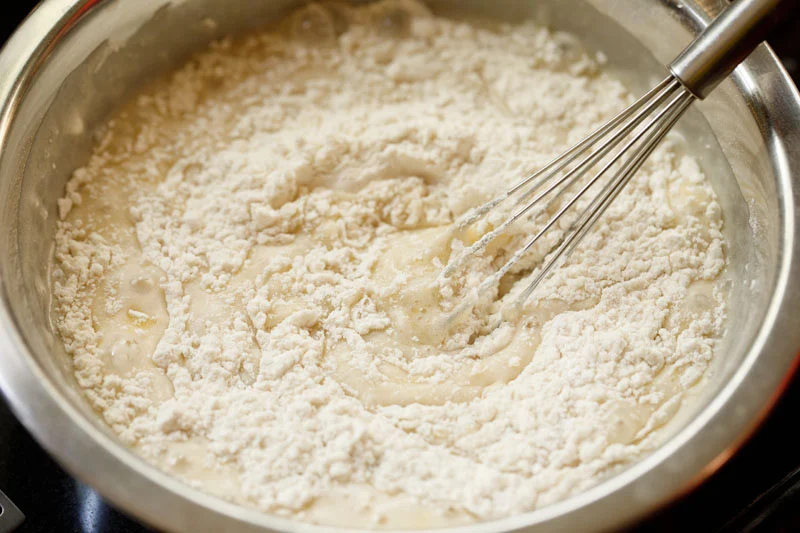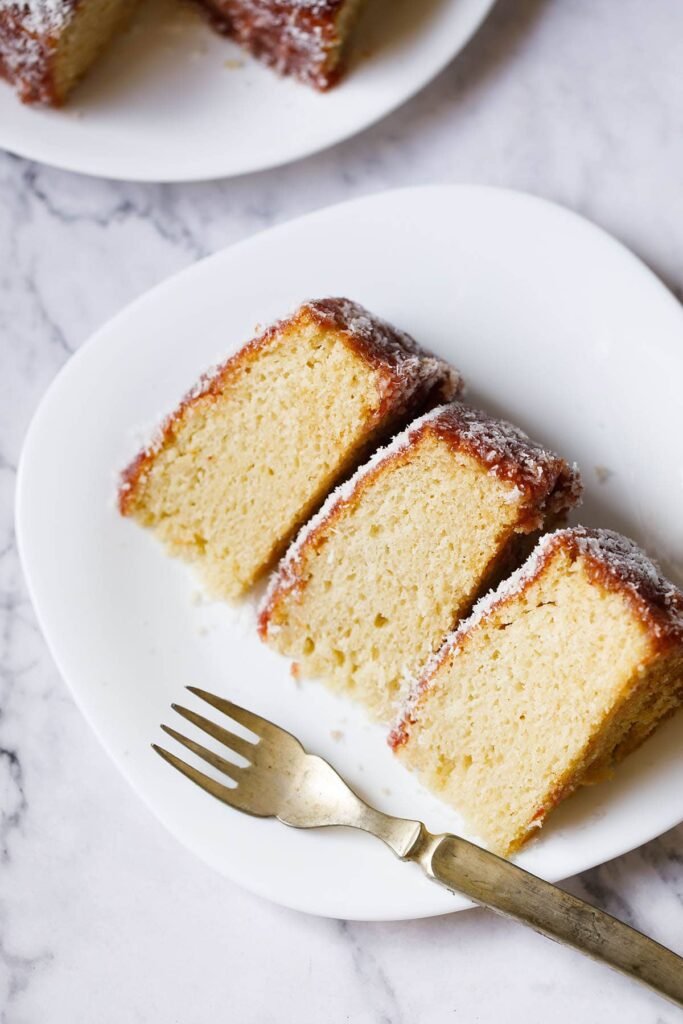This easy Eggless vanilla cake recipe makes a perfectly moist and flavorful sponge every time. It’s delicious to enjoy with a homemade strawberry glaze or use as a base for many cream cakes and gateau. Here you’ll find my step-by-step instructions, video with photos, plus expert tips for making a no-fail vanilla cake for your next celebration.

Prep Time: 15minutes mins
Cook Time: 35minutes mins
Total Time: 50minutes mins
Ingredients:
Dry Ingredients
- 1.5 cups all-purpose flour or pastry flour – 180 grams
- 1 teaspoon baking powder
- 1 pinch salt
Wet Ingredients
- ½ cup melted butter – unsalted
- ¼ cup Curd (yogurt) – 62 grams
- ½ cup water
- ¾ cup raw sugar or white sugar – 150 grams
- 1 teaspoon vanilla extract or ½ teaspoon vanilla essence
- 1 tablespoon apple cider vinegar,lemon juice, or white vinegar
- ½ teaspoon baking soda
Jam Glaze Icing
- ½ cup strawberry jam or any sweet fruit jam
- 1 tablespoon tapioca starch arrowroot flour or cornstarch
- 3 tablespoons water or add as required
- 1 tablespoon Butter – unsalted
Directions:
1. First add 1.5 cups of all-purpose flour with 1 tsp of baking powder and a pinch of salt into a sieve placed over a mixing bowl.

2. Sift the dry ingredients once or twice. Set aside.

3. Grease a 7.5 or 8-inch round pan with some butter. You can line the pan with parchment if you prefer.
One of my ancient (but really sturdy and well-seasoned) baking pan in the photo below.

4. Heat slightly more than ½ cup of butter in a small pan or bowl on medium-low heat until it just melts.

5. Measure the melted butter in a ½ cup measuring cup. Set aside. Preheat your oven to 190 degrees Celsius (375 degrees Fahrenheit) for 15 to 20 minutes before baking.

6. In another bowl add ¾ cup of raw sugar (or white sugar), 1 teaspoon of vanilla extract, ¼ cup of curd (yogurt), and 1 tablespoon of apple cider vinegar.
Note: Beat the curd separately in a bowl and then add. Also, use fresh curd and not sour curd.
Tip: Swap with white vinegar or lemon juice if you do not have apple cider vinegar.

7. Add ½ cup of water.

8. Whisk briskly until all of the sugar is dissolved and the curd gets evenly mixed. It should be like buttermilk, slightly off-color and foamy.
It is important that you beat the curd before adding as mentioned above so that you don’t have tiny lumps of curd in this liquid mixture.

9. Now add ½ teaspoon of baking soda to the wet mixture.

10. Stir until the baking soda is mixed evenly. The baking soda will cause some bubbling in this wet liquid mixture.

11. Add the liquid mixture and melted butter to the dry-sifted ingredients.

12. Mix very well with a wired whisk. Break apart any lumps by tapping them with the whisk. Be careful not to over-mix the batter.

13. It should be a smooth batter like in the photo below.
Tip: If the batter becomes too thick or looks dry, add some more milk or water (at room temperature) to get it to the desired consistency. Depending on the flour texture and quality, you will need to add more or less water.

14. Pour the batter into the greased pan. Tap the pan on the countertop a few times so that any extra air bubbles are released and the batter spreads itself evenly in the pan.
You do not need to even the batter with a spatula. The batter spreads on its own.

15. Place the cake pan in the preheated oven on the middle rack. If using an OTG or a regular oven, heat both the top and bottom heating elements.

16. Bake at 180 degrees Celsius (375 degrees Fahrenheit) for 30 to 35 minutes, or until the top crust is golden.
Tip 1: The baking time varies with various oven types and the temperatures are not the same. Thus this eggless vanilla cake recipe can take less or more time to bake in your oven. Keep an eye on the cake as it bakes so that it does not brown too much.
Tip 2: Remember not to open the oven door until ¾ of the cake is baked. Opening and closing the oven door many times can make your cake sink or collapse.
Tip 3: When the cake begins to get golden and you see that is browning very quickly, then cover the top with an aluminum foil or butter paper and continue to bake.

17. Check the doneness of the eggless vanilla cake with a bamboo skewer. It should be clean with no sticky batter on it.

18. Place the pan on a wired tray or rack and let the cake cool to room temperature. Let the cake cool completely before you spread the jam glaze on it.

Make Jam Glaze Icing
This eggless vanilla cake is delicious as-is, with no toppings needed. However, fresh fruit jam, buttercream icing, or rich chocolate ganache are yummy options to make the cake an extra special sweet treat.
Before you frost the cake, make sure it is cool and not at all hot.
To make an easy jam glaze,
1. First add ½ cup of any sweet fruit jam of your choice in a small skillet or pan. I have used Homemade Strawberry Jam to make this recipe for topping the cake.
2. Now add 1 tablespoon of tapioca starch or arrowroot flour or cornstarch, plus 3 tablespoons of water (or more if needed) and 1 tablespoon of butter.
You can use any type of starch-based edible thickener that is available to you. All the three starches that I have listed above thicken the glaze nicely.
So include any one of them for thickening the glaze. In the below photo, the white-colored flour is tapioca starch.

3. Place the pan on low heat and begin to mix.

4. Keep stirring until all of the ingredients have melted together and are evenly combined.

5. Simmer on low heat for 3 to 4 minutes until the glaze thickens, stirring often. Do not boil or cook the mixture down too much.
Set aside and allow the jam glaze to cool slightly so that it is warm and not hot.

Frost Cake:
1. When the eggless vanilla cake cools, remove it gently from the pan. Place it on a board, tray plate, or a cake stand. A rotating cake stand makes applying the glaze easiest.
Place some of the jam icing on top and use a spatula to spread the glaze evenly on top and sides of the cake.

2. Sprinkle some unsweetened desiccated coconut on top. You can even spread it at the sides.
Coconut is optional and you can skip it if you are not a fan of coconut.

3. Cover with a large steel bowl, taking care that the coconut and icing do not touch the bowl. Let the glaze cool completely and set.
Later slice and serve. You can also keep it in the refrigerator for 1 to 2 hours and then serve.
Note that the butter solidifies when cooled in the refrigerator. This makes the texture of the cake slightly dense.
So let the cake come to room temperature before serving. Or you can warm it lightly in your oven at 90 degrees Celsius (195 degrees Fahrenheit) for a few minutes.

Ingredient Notes & Variations :
- Flour: I recommend that you use unbleached and/or organic flour. This recipe works well with both all-purpose flour as well as unbleached pastry flour.
- Butter: You can use a neutral oil in place of butter. For butter, use unsalted butter. In a pinch, you can opt for salted butter, but omit to add that pinch of salt to the recipe.
- Jam: Any sweet jam works well for the glaze in this eggless vanilla cake recipe. My favorites are orange jam, mango jam, pineapple jam, and of course strawberry jam.
- Vinegar: If you do not have apple cider vinegar, use white vinegar or swap vinegar with lemon juice.
- Sweeteners: To make the eggless vanilla cake less sweet, you can add ½ cup of sugar. In place of sugar, you can also use jaggery, coconut sugar, or palm sugar. But the color of the cake will change and become dark. The taste of these sugars will also make the cake taste different.
- Leavening ingredients: My recipe includes both baking powder and baking soda. They are not replaceable with each other. To get the best results, I suggest following the proportions mentioned in the recipe. Do make sure that both baking powder and baking soda are fresh and within their shelf-life.
Baking and Storage Tips
- Baking time: The baking time varies with oven types, temperatures inside the oven, etc. So it can take less or more time for the cake to bake in your oven. Keep an eye on the cake as it bakes so that it does not brown too much.
- Storage and reheating. Leftovers can be stored in the fridge for up to 4 days, in a sealed container or box. When you refrigerate this cake, the butter in it solidifies and the cake becomes slightly dense. While serving, lightly warm the cake in your oven at 90 degrees Celsius (195 degrees Fahrenheit) for some minutes.
